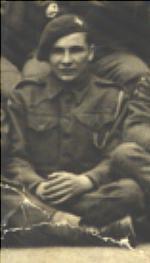Robert Lygo was born on the 3 December 1924 and came from Southwark, in London. When he was about two years old the family moved to Eltham in London.
“He had one younger brother, Peter. They both became lifelong Charlton Athletic supporters. When he left school in 1939 he got a job as a sheet metal worker making tin legs he also joined the Home Guard in 1940 - he told us they would go on duty and watch the dog fights over head.” [1a]
Robert Lygo enlisted on the 12 November 1942, and was serving in The Middlesex Regiment when he volunteered for Airborne Forces in 1943. [1b]
After completing the selection course at Hardwick Hall he was sent to RAF Ringway where he attended parachute course No 85. This ran from the 29 September to the 10 October 1943 and was a long course of 8 descents (2 x balloon by day, 1 x balloon by night and 5 x aircraft).
His parachute instructors comments: “A good performer, overcame nervousness”. [2]
He was initially sent to the Holding Wing before being posted to the 2nd Parachute Battalion based at Stoke Rochford in Lincolnshire.
On Sunday, 17 September 1944, he took off from Salby aerodrome in a USAAF crewed Dakota bound for DZ ‘X’ near Heelsum in Holland as part of ‘Operation Market-Garden’.
He was part of a PIAT team, consisting of Lance Corporal Charles Waddilove, who was the Commander, himself as No 1 and Private Syd Blackmore as No 2.
During the action at Arnhem Bridge he was wounded and suffered a dislocated knee. When their positions were over-run he was taken prisoner and sent to the temporary hospital at Apeldoorn, where he remained until the 3rd October 1944. This was when a ‘batch’ of walking wounded were transported by train to POW Camps in Germany.
Private Lygo spent the remainder of the war at Stalag XIB, at Falingbostel, with the POW No. 118130. “When he was taken prisoner of war after Arnhem he was indeed at stalag XIB, but he was also sent salt mining near to the Polish border and was also forced marched away from the advancing Russians. when eventually they were locked in a camp by the Russian’s (according to Sid Blackmore) they were not best pleased with this and escaped on a horse and cart. There were four of them and it was a bitterly cold winter, many German families put them up at night and they would in turn protect them from the Russian’s”. [1a]
For his actions at Arnhem he was initially recommended for the award of the Distinguished Conduct Medal, in December 1944. This recommendation was returned to the Unit for re-submission, which was carried out in March 1945, this time for the Military Medal. This was agreed to in July/August 1945, and was announced in the London Gazette on the 20th September 1945. [3]
"During the Battle for the Bridge at Arnhem, Private Lygo was No.1 of a PIAT detachment attached to No.3 Platoon. This Platoon was holding a forward position, east of the Bridge, and was subjected to almost continuous enemy attack. On the 19th September three armoured cars approached close to the Platoon and started firing into the building. Private Lygo fired four bombs obtaining three direct hits and thus forcing them to withdraw. During this time the fire of the armoured cars was directed almost entirely against him. Soon after this two Mark III tanks approached and shelled the Platoon at very close range. Once again, though under heavy and direct fire, Private Lygo engaged the tanks and succeeded in burning out one and forcing the other to withdraw. Private Lygo's PIAT was the only Anti-Tank weapon in the vicinity and it was mainly due to his coolness and courage in the face of devastating fire that the Platoon was able to hold this house for so long. Throughout these engagements he was isolated from the remainder of the Platoon and was acting entirely on his own initiative. On the second occasion he deliberately exposed himself to heavy fire in order to work his weapon forward to a position where he could get a more accurate shot."
The initial recommendation can only have come from Major. Tatham-Warter, after his escape and rejoining the Battalion in October/November 1944. The top signature for the recommendation on the Citation, in 1945, is that of the then Commanding Officer, Lieut-Colonel. J.W.B. Marshall, and is then endorsed by the 1st Parachute Brigade Commander, Brigadier. G.W. Lathbury, followed by the 1st Airborne Divisional Commander, Major-General. R.E. Urquhart.
After his release from the POW Camp, returning home and his survivors leave, he transferred back to The Middlesex Regiment on the 6th October 1945. [1b]
“After the war he got a job pipe laying. He was working up in Bradford, West Yorkshire, where he met my mother. He got a job as a plumber at FL Sanderson & Sons, where he worked until the day he died. They had 7 children, but the first born Margret died soon after her birth.
“My Dad sadly died on the 25 June 1979 aged 53. He would never talk about the battle when ever we asked how he won his medal he would just say “my name was the first out of the hat!” [1a]
NOTES:
[1a] From Walter Lygo. July 2024.
[1b] The Parachute Regiment Transfer and Enlistment Book 13, page 19.
[2] Parachute Course Report, RAF Ringway. October 1943.
[3] 1st Airborne Division Honours and Awards Book and the Citation.
Written and researched by R Hilton.
Read More


Latest Comments
There are currently no comments for this content.
Add Comment
In order to add comments you must be registered with ParaData.
If you are currently a ParaData member please login.
If you are not currently a ParaData member but wish to get involved please register.